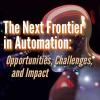Strategic advice to leverage new technologies
Technology is at the heart of nearly every enterprise, enabling new business models and strategies, and serving as the catalyst to industry convergence. Leveraging the right technology can improve business outcomes, providing intelligence and insights that help you make more informed and accurate decisions. From finding patterns in data through data science, to curating relevant insights with data analytics, to the predictive abilities and innumerable applications of AI, to solving challenging business problems with ML, NLP, and knowledge graphs, technology has brought decision-making to a more intelligent level. Keep pace with the technology trends, opportunities, applications, and real-world use cases that will move your organization closer to its transformation and business goals.
Insight
In her article, Prerna Lal discusses the use of ML techniques to address cyberthreats and explores the benefits of AI-based cybersecurity solutions.
Drones: Enterprise Mission Ready
Helen Pukszta outlines several potential enterprise applications of drones in different industry sectors with illustrative real-world examples. She briefly highlights how Part 107 of Chapter 14 of the US Code of Federal Regulations redefines commercial drone use and the risks drones pose. She also discusses the challenges and limitations of today’s drones and how those concerns are being addressed. The barriers to employing drones for business are quickly melting away, and it’s time to pursue the opportunities that drones present, she advises.
Paul Clermont discusses the adoption and impact of AI for automation. After a brief history of AI, Clermont discusses the dangers AI poses. Though technologists have perceived the dangers for some time, he notes that only now are the dangers starting to draw the attention of ordinary citizens and politicians. On a positive note, he outlines the measures that government, the tech industry, regulatory agencies, and the public are taking to address major dangers that AI and its applications present. He emphasizes government’s role in tackling the issues surrounding the use of AI and identifies a few specific areas that government should address.
Thomas Costello and Phil Laplante focus on the use of blockchain technology in automation applications. Following a brief outline of the benefits of using blockchain technology, they discuss blockchain’s potential to provide transformational improvements in business process automation (BPA) in several industry sectors. They also highlight how blockchain could improve trust in, and the dependability of, BPA and examine the challenges in practical implementation of blockchain technology. Furthermore, they present a set of customizable questions to help implementers decide whether a business process is suitable for, and can benefit from, a blockchain implementation.
We feature eight articles in this issue that cover a range of topics of interest — from technologies that drive and support new frontiers in automation, such as blockchain, AI, and security, to automation strategies and design considerations.
When I worked with the Air Force years ago, they had a requirement for every program to capture lessons learned when the product was delivered. The programs that I worked with faithfully carried out this mandate and developed reams of reports that were compiled as lessons learned databases. Unfortunately, there was no requirement to review these databases in anticipation of new starts or to make policy/procedure corrections. As a result, the suggestions and experience that they contained was often lost. Let’s see what we can do to fix this at each of the levels of retrospective.
When approaching an architecture representation, a key point is its decomposition into elements, usually leading to a containment-based representation structure. We might then navigate the architecture along the “containing” relations (for example, whenever a link is labeled as “part of” or “implements,” it is a “containing relation” by nature), or using predefined viewpoints. To reach the ideal balance in governing architecture, the challenge is to harmonize the intentional and the emergent architectures.
“Know your customer” (KYC), a key process for banks today, remains, in most cases, a very costly and long process. Most challenges lie in the efficiency of verifying customer-provided information. With digitally verified claims, verification can be improved, accelerated, and replicated on a large scale. KYC and digitally verified claims open new business opportunities for banks to act as validators for other organizations. This Advisor explores two case studies of KYC implementation.



















